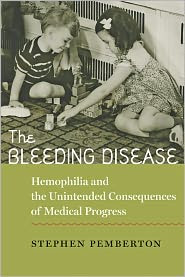 About the book, from the publisher:
About the book, from the publisher:By the 1970s, a therapeutic revolution, decades in the making, had transformed hemophilia from an obscure hereditary malady into a manageable bleeding disorder. Yet the glory of this achievement was short lived. The same treatments that delivered some normalcy to the lives of persons with hemophilia brought unexpectedly fatal results in the 1980s when people with the disease contracted HIV-AIDS and Hepatitis C in staggering numbers. The Bleeding Disease recounts the promising and perilous history of American medical and social efforts to manage hemophilia in the twentieth century.Learn more about The Bleeding Disease at the Johns Hopkins University Press website.
This is both a success story and a cautionary tale, one built on the emergence in the 1950s and 1960s of an advocacy movement that sought normalcy—rather than social isolation and hyper-protectiveness—for the boys and men who suffered from the severest form of the disease.
Stephen Pemberton evokes the allure of normalcy as well as the human costs of medical and technological progress in efforts to manage hemophilia. He explains how physicians, advocacy groups, the blood industry, and the government joined patients and families in their unrelenting pursuit of normalcy—and the devastating, unintended consequences that pursuit entailed. Ironically, transforming the hope of a normal life into a purchasable commodity for people with bleeding disorders made it all too easy to ignore the potential dangers of delivering greater health and autonomy to hemophilic boys and men.
Pemberton is Associate Professor in the Federated History Department at New Jersey Institute of Technology and Rutgers University, Newark, and a historian of medicine, biomedical science and technology, and public health.
The Page 99 Test: The Bleeding Disease.
--Marshal Zeringue





